Misty-eyed for Myst?
Casual Compensations
By Becky Waxman
Myst
released in 1993 and was my introduction to video gaming. It was developed
by Cyan (now
Cyan
Worlds) and spawned multiple sequels plus an online multi-player game
that's currently in its fourth iteration (MO:ULagain).
Nearly two decades after the original
release, I returned to Myst Island to see how well the experience holds up.
Despite its age (and difficulties running it on my Win 7, 64-bit system),
Myst remains an extraordinary experience. Its influence was huge and
inspired game developers to release similar adventure games frequently over
the following decade. That influence has eroded, with the
RHEM
games as the lone surviving Myst-like series which adventure
gamers can dependably anticipate.
Certain adventure-lite and Interactive
Hidden Object Games exhibit elements that remind me of Myst. Can
adventure gamers scratch that Myst itch by playing casual games?
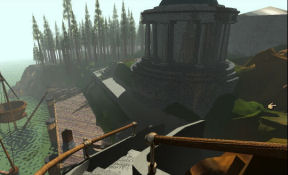
Essence of Myst
First, what is Myst? It's an
adventure game using the first person perspective and evoking a sense of
isolation. You visit other Ages (worlds) using unusual portals found in
books. You briefly encounter characters and/or creatures, but for the most
part you are alone.
The gameworld is large, naturalistically
rendered, with surreal details -- a model ship sunk in a fountain, a giant
gear, a clock rising up from the sea. Exploration is nonlinear and
frequently takes place out-of-doors, though you'll also discover underground
or underwater chambers and rooms with evidence of engineering experiments
and ingenious inventions. Ambient sounds and music contribute to an eerie
atmosphere.
The Ages (and you, the player) are
threatened by an evil force waiting to be identified and then reckoned with.
Much is hidden; nothing is quite what it seems. Background story information
is conveyed in books or journals, along with sketches and other
illustrations.
Odd symbols and even odder machinery
populate the fantastical environments. You analyze clues, discern the
connection of parts, activate devices, and solve the mystery of how and why
the world works the way it does.
How Myst Differs from Casual Games
The Ages in Myst are not environments
with puzzles, but actual puzzle worlds. They are also much larger than
gameworlds in typical adventure-lite or Interactive Hidden Object Games.
Certain thematic differences -- engineering versus magic, for instance --
are also apparent.
Gameplay Differences
Casual game puzzles might use similar
mechanical principals to those in Myst, but they aren't woven into
the world in the same way. In the pipe puzzle in the Channelwood Age, you
aren't looking at a top-down single screen with a configuration of pipes --
you're walking next to the pipes on a boardwalk, listening to the water and
throwing switches. In the maze challenge in the Selenitic Age, you aren't
manipulating a marble in a miniature labyrinth -- you're inside the maze
itself. For a sound puzzle, you travel all over the Age, listening, taking
notes, and then trying to find the control panel in which to input the
information. In contrast, the challenges in casual games are more separate
and discrete. They are more like mini-games. (The term mini-game throughout
this editorial does not refer to a timed arcade game like "Whack-A-Mole,"
but rather to an untimed, self-contained puzzle viewed in a close-up
screen.)
Myst
puzzles are multi-layered, and much more exploration per puzzle is required
than in casual games. Often clues are separated spatially from their
solutions. Turning a valve doesn't always cause a change nearby, but often
several screens away. The environments in Myst are large enough that
just staying oriented can be a challenge. In contrast, I've seldom felt lost
or disoriented in casual games.
In casual games, the means to solve puzzles
is usually closer at hand -- if only because the gameworlds are so much
smaller. An optional hint system is common in casual games, as is an opt-out
or skip feature for the more difficult puzzles.
Thematic Differences
The linking books in Myst seem
supernatural, but a scientific basis exists for them. In casual games, the
stories trend more toward magical fantasy (even fairy tale fantasy), rather
than science fiction. Though Myst's environments are detailed, they
are seldom cluttered -- the acquisition of multiple objects and the
accoutrements of wealth are symbolic of corruption and greed. In casual
games, there is so much more "stuff"! This is true of the Hidden Object
screens, of course, but also of the environments in general.
Six
Myst-like Casual Games
I've selected six casual games that --
though they won't completely fulfill the Myst yearning -- have
elements similar enough to evoke nostalgia, while introducing new types of
gameplay and suitably surreal worlds. All use the first person perspective
and all have a point-and-click interface. The first three games are
adventure-lite games. The other three are Interactive Hidden Object Games
(sometimes inventory items are acquired by locating objects corresponding to
a word list at the bottom of the screen).
All are part of various ongoing series. I've
chosen a particular game from each group because of its Myst-like
qualities or because I thought it would be a good place to start. If you
find that you like a particular game, you should check out the other games
in that series.
Note: I'm aware that many gamers play casual
games in the company of a child. All the games below are like Myst --
gameplay is generally family friendly, though the story and some of the
visuals imply past acts of violence.
 Pahelika:
Revelations
Pahelika:
Revelations
Pahelika: Revelations
is the sequel to the adventure-lite game, Pahelika: Secret Legends.
You assume the role of a young man who has stumbled across the Pahelika
puzzle book with the magical ability to transport him to other worlds. In
Revelations you uncover the history of the civilization that engendered
Pahelika while doing everything you can to stop a power-hungry wizard.
Graphics are naturalistic with a subdued
color palette and intricate use of shadow. The environments include
courtyards and monumental buildings of stone. The background music suits the
locations, ranging from relaxed, rhythmic electronic melodies to a wash of
sound using exotic pipes. The graphic novel-like cut scene panels are
supplemented by dramatic orchestral music.
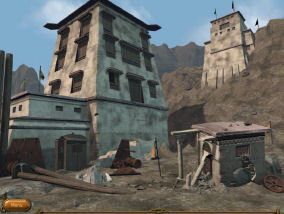
You interact with a handful of characters,
including a ghost, a sage and a grouping of sentient stone heads. The game
is partially voiced.
You don't have access to a diary that is
available throughout the game; however you frequently read brief sections of
books and papers. The story in-game is somewhat disjointed; reading the
background information in the "Pahelika:
Revelations Strategy Guide" is helpful. Like Myst, the story
strives for moral tension and even some moral ambiguities.
Challenges are varied: frequent inventory
puzzles (including inventory combinations), a tricky set of riddles,
sequencing challenges, jigsaw-like puzzles, spell-casting, and pixel
hunting. The puzzles start out tough and get tougher. Even the "Casual mode"
poses a significant challenge. The puzzles are packed tightly together, and
the game feels more puzzle-heavy than Myst. Mechanical puzzles
include the hydraulic bed puzzle, the key making puzzle, and the vault
mirror challenge. (Pahelika: Revelations does not have Hidden Object
challenges.)

Dream Chronicles: The Book of Air
The Book of Air
is the fourth game in the Dream Chronicles series, and the start of a
new trilogy. You assume the role of Lyra, half-human daughter of Faye, the
heroine from the original trilogy. As the game opens, Lyra discovers that
everyone in the town of Wish has disappeared and that she has slipped into a
different time dimension. She must travel in a Jules Verne-esque airship to
petition the Clockmaker -- a wizard/mechanic living atop a giant pedestal in
the frozen northlands. The Clockmaker is rumored to be the master of time.
Complications arise in the quest to heal the
timestream, and Lyra's efforts take her even further afield to more quaint,
imaginative locations. Contemplative music using pipes and strings adds to
the overall otherworldly effect, as do the subtle animations of clouds and
water.
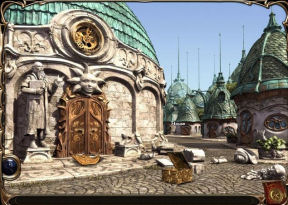
Lyra keeps a journal that includes story
details and speculations. It becomes clear that her family hasn't been
honest about her heritage. The game contains practically no character
interaction. Lyra's thoughts are usually voiced, as are the letters she
receives from Grandfather Tangle.
This adventure-lite game will have you
deciphering messages, arranging patterns, using inventory items, casting
spells, and solving mini-games with gears and colored stones (difficulty
level: medium) . Mechanical puzzles include rotating the wind columns, the
walnut channeling challenge, and the symbol imprinting puzzle. This game
does not have Hidden Object "find" lists; however, you search each location
for tiny dream pieces. Combining the pieces creates jewels that enable
certain abilities -- among them the ability to shed light and transmute
substances.
The Book of Air
takes you to the point where one quest ends and another begins; the story
continues in the sequel released in 2011 -- Dream Chronicles: The Book of
Water.
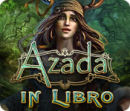 Azada
in Libro
Azada
in Libro
You've been bequeathed a fortune from a
mysterious relative you've never met. You travel to Prague to claim your
inheritance, and find that you have acquired, not an inheritance, but a
quest to save three worlds. A young man named Titus explains that his uncle,
the dark magician Argus, is drawing power from three of Azada's worlds, each
accessible through the pages of a book. The guardians for each world have
disappeared. You are tasked with finding three magic keys, restoring the
guardians if they are still alive, and defeating the evil Argus.
Of the six games presented here, this
adventure-lite game comes closest to the way Myst draws the gamer
into completely separate worlds. One world resembles an elegant European
town, one evokes a rustic fantasyland forest, and one is parched and dying,
with red fumes choking the sky. The graphics in Azada In Libro are
stylized with a hand-drawn effect, and contain a jaw-dropping level of
detail and animation. Ambient sounds add texture to the surroundings -- bird
calls, splashing water, metallic groans. Orchestral music -- sometimes
emphasizing plucked strings -- and a particularly lyrical piano melody add
to the atmosphere.
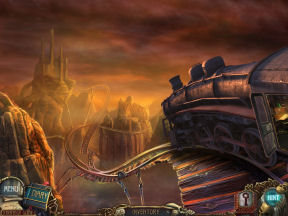
You interact briefly with Titus, the Azada
guardians, and a handful of creatures. The game is partially voiced. A diary
contains the highlights of the story as you progress. It's illustrated with
colorful sketches and occasionally records information needed to solve
puzzles.
Many of the challenges are multi-stepped.
Often they start with inventory challenges that progress to mini-games that
resemble the mechanical puzzles found in Myst. For instance, getting
the hook from the clockwork skeleton, assembling potions to activate the
chimera portal, and moving a stalled train down the track. The difficulty of
the challenges varies, though no truly dastardly puzzles are among them. In
addition to inventory puzzles and mini-games, the game features jigsaw-like
puzzles and pattern and assembly challenges. It has no Hidden Object
challenges.
The Standard Edition of Azada in Libro
ends rather abruptly. The Collector's Edition has extra gameplay that brings
a greater sense of completion.
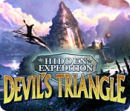 Hidden
Expedition: Devil's Triangle
Hidden
Expedition: Devil's Triangle
You're on a rescue mission to recover a
pilot who works for the Hidden Expedition Adventure Team. The pilot
apparently went down somewhere within the Bermuda Triangle. Gameplay starts
in a submarine -- a puzzle-heavy environment. After a tussle with some
pirates, you escape to a series of islands; one is the home to inventor
Gideon Forsythe, who claims to have known Leonardo da Vinci.
Due to a device called The Da Vinci Node,
certain natural laws operate differently here, making the islands feel like
an alien world. You interact with several over-the-top characters whose
isolation has left them somewhere on the spectrum between goofy and insane.
The game is partially voiced.
The island locations are quirky, with
classical structures next to biological oddities and crazy but functional
inventions. Frequent animations -- along with haunting orchestral melodies
and threatening background noises -- enhance the sense of a massive science
experiment gone terribly wrong.
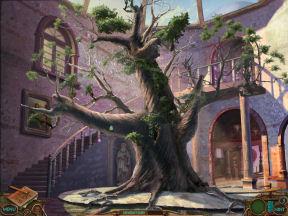
A log contains character files, objectives,
and travel journal notes with photos, hand-drawn illustrations and sketches.
These follow the story, sometimes give hints, and are written with broad
tongue-in-cheek humor.
Devil's Triangle
is an Interactive Hidden Object Game featuring frequent inventory
challenges, including item combinations. You also decipher codes, mix
explosives, interpret scientific notes, sequence symbols, and play
mini-games. Some Hidden Object screens use traditional "find" lists, but
others are more creative -- including pairing items by association, finding
multiple items by type, and interacting with objects layer by layer. Puzzle
difficulty is medium to hard. Mechanical puzzles include the sonar puzzle,
the door constellation challenge, and the Powerchord giant instrument
extravaganza.
The game ends in a cliffhanger; the sequel,
Hidden Expedition: The Uncharted Islands, released a few months ago.
 Empress
of the Deep 2: Song of the Blue Whale
Empress
of the Deep 2: Song of the Blue Whale
This sequel to Empress of the Deep: Dark
Secrets opens as the protagonist, Anna, manages to escape the imploding
underwater world once ruled by her family. She must find a way to reach an
abandoned city floating among the clouds.
After repairing a hot air balloon, Anna
puzzles her way into the city in this Interactive Hidden Object Game. An
unknown voice penetrates her mind. It's mournful and pompous, and advises
her that sentient beings have been enslaved and trapped here (brief
interactions take place with each of these creatures). Anna must look
deeper, into odd corners and hidden chambers, uncovering secrets about the
royal family's past struggles. A colorfully illustrated diary contains
descriptions and pictures of the locations. The game is fully voiced.
Song of the Blue Whale
contains one interface oddity -- when you finish with a location, the game
puts a large "Area Clear!" medallion in the top right hand corner. This
eliminates much back-and-forthing, but reduces the feeling of "being there"
immersion.
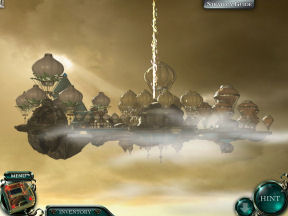
You will encounter many inventory puzzles,
matching and sequencing challenges, and some mini-games. Difficulty level is
easy to medium. Hidden Object screens with a traditional "find" list
occasionally appear. Mechanical puzzles include the laser/mirror mini-game,
the wire connection puzzle, and the frogs' heads sequencing challenge.
This game's greatest strength is its
spectacular landscapes and skyscapes with their unexpected juxtapositions of
natural elements. Winged dolphins ornament a staircase, stone visages emerge
from a rippling pool, and diamond-shaped balloons ring the walkways. Clouds
blow across the sky and mystical music reverberates in the background.
Ambient sounds include the rustle of colorful foliage, the sound of grinding
metal, and an occasional ominous cackle. The gameplay challenges are, for
the most part, rather easy. The gameworld is particularly large for a casual
game -- staying oriented is actually more challenging than some of the
puzzles.
 Mystery
Trackers: The Void
Mystery
Trackers: The Void
In this Interactive Hidden Object Game, you
assume the role of a rookie detective in a secret agency that investigates
mysteries with "mystic or enigmatic" aspects. The old Void mansion has
recently been in the news because three celebrities each attempted to spend
the night there and subsequently vanished.
The mansion used to be the home of Dr.
Malleus Void, an eccentric inventor/mad scientist spurned by the scientific
community. Malleus had planned to turn his large estate into an amusement
park to publically display his scientific discoveries. But the plans were
never realized, and Malleus is now dead.
You roam the grounds of The Void and stumble
across the remnants of Malleus' freakish biological experiments. You also
discover evidence of the three celebrities, deepening the mystery. Sparse
interaction occurs with a couple of characters and creatures; there are no
voiceovers.
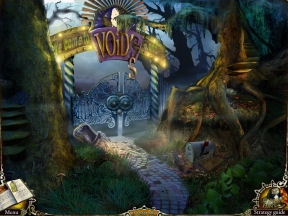
The Void's
locations are photorealistic with a collaged, dreamlike effect. Dramatic
orchestral music, occasionally with a contemporary flair, adds to the
ambiance of corruption and threat. The interface features interesting
sounds, with the diary pages flapping, inventory items making appropriate
noises, and the hint system croaking.
The game's diary (the best of the six games
mentioned here) is layered with photos, drawings, letters, speculations and
clarifications. The story in this game is tantalizingly presented and had me
speculating feverishly and anticipating the outcome.
Challenges include lots of Hidden Object
screens, plus inventory puzzles and mini-games. Mechanical puzzles include
the pump assembly, the three dimensional compass, and the phonograph
programming challenge. The puzzles are quite easy at first, but increase in
difficulty as the game progresses. (You can increase mini-game difficulty by
not consulting the optional "information" clues.)
Could Casual Games Spring from the Myst
Universe?
Will we ever see Cyan Worlds creating casual
games that continue the Myst story? I couldn't help speculating about
this possibility while I played the games mentioned here. It would require
adjustments.
One adjustment: 3D graphics are expensive
and many casual gamers aren't used to navigation through 3D worlds. A casual
Myst series would probably mean a return to 2D graphics that are more
like those of the original Myst than those of the later, 3D
realMYST.
A graduated hint system, or a way to select
difficulty level would have to be introduced into any new Myst-based
casual game -- something way more explicit than the hint system in Myst:
Masterpiece Edition.
Adventure gamers who are Myst fans
would adjust their expectations too. The gameworlds would be smaller than in
the past Myst adventure game releases. Even with a hint system, the
multi-layered, difficult puzzles that shout "Myst!" would probably be
simplified.
Casual gamers who are comfortable with
Interactive Hidden Object games would need to adjust to the absence of
Hidden Object screens, less interactivity per location, reduced inventory
items, increasing subsidiary steps for solving puzzles, and the need to
observe patterns in the gameworld that won't be useful until much later in
the gameplay.
Could this happen? Or is mine just a
fevered, surreal dream?
Coming up Next
Look to this space to see
more discussion of casual games. Next up: Classic Tales Into Games
**Note: some of the ideas
for the article were influenced by From Myst to Riven: The Creations &
Inspirations by Richard Kadrey.
copyright © 2012
GameBoomers